Weather Almanac for April 2005
HALO! HALO!

"For I fear a hurricane;
Last night the moon had a golden ring
And tonight no moon we see."
Henry Wadsworth Longfellow, The Wreck of The Hesperus
In this poem, Longfellow refers to one of the longest standing — and generally correct in the mid-latitudes — pieces of weather lore: the appearance of a halo around the sun or moon as a harbinger for coming storm and precipitation. Richard Inwards classic collection Weather Lore (1893) lists no less than thirty weather rules, sayings, or proverbs pertaining to halos.
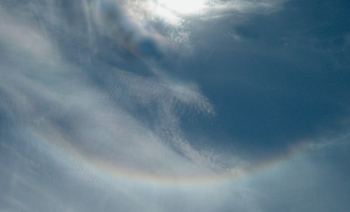 The facts behind this piece of lore tell us that very often in the cloud decks around a storm system, an extensive band of cirrostratus clouds lies ahead of an approaching warm front. In the majority of cases, when sun- or moonlight passes through these ice clouds, a halo forms around it. In the typical textbook storm and front sequence, cirrostratus follows forerunner cirrus clouds and precedes the lowering of the cloud deck until precipitation develops in the nimbostratus near the warm front. In other circumstances, cirriform-clouds may develop in the anvil of approaching thunderstorms and sport a foretelling halo. The facts behind this piece of lore tell us that very often in the cloud decks around a storm system, an extensive band of cirrostratus clouds lies ahead of an approaching warm front. In the majority of cases, when sun- or moonlight passes through these ice clouds, a halo forms around it. In the typical textbook storm and front sequence, cirrostratus follows forerunner cirrus clouds and precedes the lowering of the cloud deck until precipitation develops in the nimbostratus near the warm front. In other circumstances, cirriform-clouds may develop in the anvil of approaching thunderstorms and sport a foretelling halo.
Halos can also often be seen downwind of the summit ridge of a high mountain range through orographic ice clouds — those clouds formed when moist air pushes high over the mountains. A fourth category of halos develops in light show showers and even in clear frigid air. For this reason, the polar regions often produce the world's most impressive displays of halos. The best are seen in the Antarctic interior where the ice crystals tend to pure and homogenous in shape and size (see South Pole halo display below).
What Is A Halo?
By broad definition, a halo is a group of optical phenomena, in the form of rings, arcs, pillars, or bright spots around the sun or moon, produced by the refraction or reflection of light by ice crystals suspended in the atmosphere (The National Snow and Ice Data Center, Boulder, CO).
This definition includes ice crystal optical phenomena that I have written about elsewhere (light pillars, and sun and moon dogs) and some very interesting but infrequently seen phenomena such as Parry arcs, anthelion and a variety of tangent arcs. The word halo conjures up the image of a circle, but the majority of halo phenomena are not seen as complete circles, appearing rather as arcs with enough curvature to suggest a circle fragment.
Here, I intend to narrow my discussion to the two most common halos, the 22-degree and the 46-degree halos. Halos arise in all seasons when cirriform clouds are present, but the winter months often offer the best conditions for seeing halos as frontal storms pass along the southward-dipping polar front and frigid air provides a favourable environment for ice crystal formation at all altitudes. In warmer periods of the year, high altitude cirrus clouds may form vast ice-crystal sheets through which the sun or moon may shine and form halos.
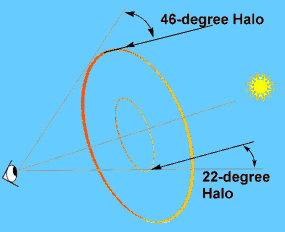
The Crystal Base
Halos and related phenomena are produced by the refraction, spectral splitting and, at times, internal reflections of light by ice crystals suspended in the atmosphere. Ice crystals form in a variety of hexagonal shapes depending on air temperature and humidity, but those crystals responsible for halos are usually elongated columns and flat plates. In crystal terminology, the hexagonal face of the crystal is called the basal facet and the six rectangular faces connecting the two basal facets are called the prism facets. Typically, the larger crystal dimension is 0.05 to 0.1 mm across. The column and plate crystal shapes are similar except for their relative prism facet depth which is long in columns and thin in plates. If the ratio of the height to the basal facet radius is less than two, the crystal is considered a plate, otherwise it is a column. You can think of a plate as a squished column or a column as a drawn-out plate.
 |
The column pattern of ice crystals (left) looks like the shape of a common lead pencil (but, of course, much smaller). Its prism facets are long compared to the width of the basal facets. Ice columns typically form in the temperature ranges -5oC to -8oC (23oF to 18oF) and below -25oC (-13oF). Larger column crystals fall with their long axis parallelling the ground, and at times, while falling the columns may rotate like slow, miniature helicopter blades. |
 |
The hexagonal-plate crystal patterns (right) are flat and hexagonal with the basal facet width much larger than the prism facet depth, resembling microscopic stop signs or dinner plates. The formation of plate crystals is favoured at air temperatures from 0°C to -4°C (32°F to 25°F) and from -10oC to -20oC (14oF to -4oF). When their size is very small, crystal plates tumble randomly through the air as they fall. When larger plate-shaped ice crystals fall unimpaired, drag forces orient them horizontally so that their larger, basal facet surface parallels the earth, descending like a large maple leaf drifting down from a tree.
Forming Halos
When plates and/or column ice crystals are suspended in the air, bright light passing through them will be refracted on entrance to the crystal and again on exit. These refracted light rays split into a spectrum of colours with red-orange on the inside and blues in the outer band. The most dominate colours in a halo are usually the longer wavelengths: red, orange and yellow. There are several reasons for this including a tighter angle of spread for longer wavelengths and more scattering and absorption of the shorter, blue wavelengths. Often, the bluish sky background masks the shorter wavelengths. In many circumstances, the mixing and dispersion of colours from many crystals produce a whitish halo brighter than the surrounding sky.
While typical crystal dimensions are 0.05 to 0.1mm, the optimum size for halo production appears to be around 0.05 to 0.2 mm for the larger facet. When crystals are smaller than 0.01 mm, halos are weak and diffuse. Crystals larger than 0.05 mm refract and reflect light cleanly to produce distinct halos. The sharpest halos occur when the crystals have precisely aligned crystals larger than 0.1 mm.
Regardless of their proportions (lengths as well as facet ratios), all crystals have identical angles among the facets which produce regular and predictable halos. The three angles are 60o, 90o and 120o, the last angle playing the least significant role in halo phenomena. (While the angles making up the hexagonal facet are 120o each, the passage of light through a hexagonal crystal acts as if it has passed through a 60o triangular prism.) As a result, researchers studying the halo family classify halos as either 60o or 90o events.
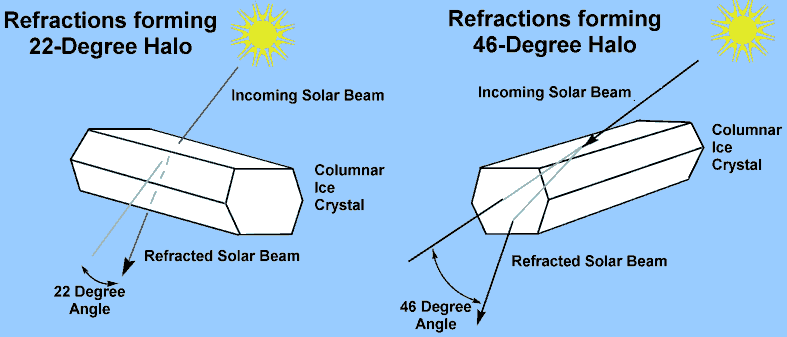
In passing through two faces of the hexagonal facet, the light path deviates from the straight line path by 22o. Should the light ray pass through two faces whose angle forms 90o, the deviation from the straight line is 46o. These are the two most common paths and form the two most common halos: the 22-degree halo and the 46-degree halo.
In a cirrus cloud, aerodynamic forces orient the falling ice crystals to some degree of regularity based on their shape. Plates generally fall like leaves with their broads facet facing up/down, but may tumble around their horizontally-aligned axis. Column crystals also often fall with their long axis in the horizontal and may rotate around that axis or around their vertical axis like a helicopter's propeller blade. Halo phenomena arising from spinning crystals produce the most complex patterns because their presentation to the sun/moon light changes greatly.
When there is a range of crystal sizes and shapes with a mix of stable orientations, random orientations and spinning crystals, many different halo phenomena may be presented simultaneously. Such halo displays are often observed in the optimum conditions of the polar regions such as the one below from the South Pole.
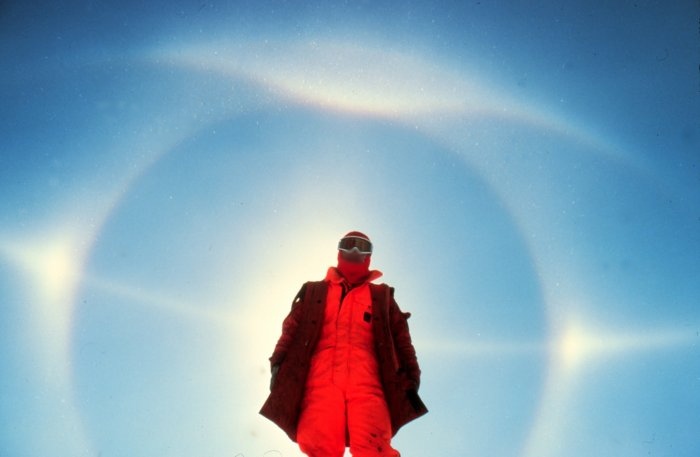
Halo Display at the South Pole
Photo courtesy Historic NWS Collection,
National Oceanic & Atmospheric Adminstration (NOAA)
Photographer: Lieutenant (j.g.) Cindy McFee, NOAA Corps
The 22-Degree Halo
Around the world and across the seasons, the most commonly seen halo is the 22-degree halo, which may often be accompanied by sun- or moondogs. The halo is usually seen as a complete ring unless the cloud deck is localized in the sky or the sun/moon is near the horizon. The best viewing for the 22-degree halo occurs with a veil of cirrostratus overhead containing uniform-sized hexagonal column crystals. Such halos are the ones connected in weather lore with impending precipitation.
The 22-degree halo is a 60o class halo. Light rays, which go in one side of the basal facet of the ice crystal and out another side, refract in passage to form the 22-degree halo. Where the light passes through the crystals at the minimum deviation angle (approximately 22o, with slight variation due to wavelength), it concentrates into a narrow band that makes up the most visible sector of the halo. The deviation of light through randomly oriented crystals produces the appearance of a "hole in the sky," a relatively darker band between the sun and the halo where light cannot be scattered by simple refraction. It is analogous to Alexander's dark band between primary and secondary rainbows (see Rainbows, for more).
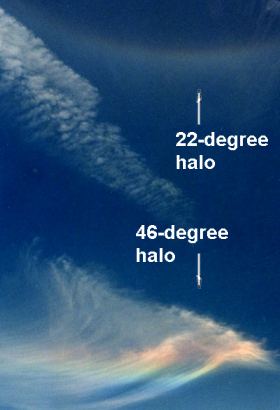 The 22-degree halo can appear as a bright white ring around the sun/moon or as a ring with some colouration. Usually, a coloured halo has a sharp, distinct red inner ring and a diffuse bluish outer ring but the spectral split in a halo rarely rivals rainbows for distinct, bright colours. In part, the reason for this more diffuse nature of a halo is due to the fact that the halo we see is actually composed of a myriad of overlapping coloured halos. Because of the geometry of the refractions, the red rays forming the inner ring have the minimum deviation angle and are not overlapped by longer wavelengths as are the outer portions of the ring. In the outer portions, colour overlap smears the colours and mat combine to produce whiter light. The 22-degree halo can appear as a bright white ring around the sun/moon or as a ring with some colouration. Usually, a coloured halo has a sharp, distinct red inner ring and a diffuse bluish outer ring but the spectral split in a halo rarely rivals rainbows for distinct, bright colours. In part, the reason for this more diffuse nature of a halo is due to the fact that the halo we see is actually composed of a myriad of overlapping coloured halos. Because of the geometry of the refractions, the red rays forming the inner ring have the minimum deviation angle and are not overlapped by longer wavelengths as are the outer portions of the ring. In the outer portions, colour overlap smears the colours and mat combine to produce whiter light.
Many relatives of the 22-degree halo form in conjunction with this ring. Most prominent are the "dogs," the sundogs and moondogs, technically known as parhelia and paraselenae, respectively. They often sit on the 22-degree halo ring along the central horizontal line bisecting the halo, with one sitting on either side of the sun/moon.
The 46-Degree Halo
The 46-degree halo, cousin of the 22-degree halo, is less frequently seen, perhaps because it does not often form a complete ring around the sun. I admit that I never really noticed one until I moved to the Pacific Coast. From my balcony I look south toward the Olympic Mountains. The low sky in that view is often covered in clouds formed when the air crosses that range, and often they are ice clouds of the cirrus family. The day I first noticed a 46-degree halo, I thought it was a rather colourful 22-degree halo segment until I looked higher in the sky and saw the true 22-degree halo. Consulting my favourite atmospheric optics guide (Lynch and Livingston's fabulous Color and Light in Nature), I confirmed that the visage was not the 22-degree halo but a 46-degree halo. Since that time, I have seen many 46-degree halos including one of nearly complete circularity.
The 46-degree halo arises from the same crystals as the 22-degree halo but from a different light path through them. Those that go in one prism facet side and then out one of the basal ends form the 46-degree halo, making it a member of the 90o event halo family. The 46-degree halo forms with the same colour sequence as the 22-degree halo and lies outside it. This halo lies at a 46o angle from the light source axis.
Because the 46-degree halo is less common than its 22-degree cousin, some investigators believe the column crystal must be "fatter" to produce the 46-degree halo. They argue that if the crystal is too long and thin like a pencil, there is too little area on either crystal end for the light to emerge through an end rather than a side. Thus, squat column crystals may be the more likely source of the halo pair.
The resulting refracted beams form a much larger ring than the 22-degree halo, its angular width spans over 90o, more than twice that of the 22-degree halo. Robert Greenler in Rainbows, Halos and Glories suggests the shear size of this halo spread across so much sky makes it hard to notice (and often putting a large portion of it below the horizon), a factor he believes contributes to its infrequent observation.
Light entering an ice crystal destined to form a 46-degree halo must enter the crystals in a very narrow range of angles and some is reflected back at both the entrance and exit facets. The light emerging will also disperse over a wider stretch of sky. As a result, the 46-degree halo generally is more faint than the 22-degree form, which may also account for its less frequent observation. However, I have noticed that the 46-degree halo, being less bright, appears show better, though subdued, colour. Those I have seen often appear as pastel-hued and the blues are more noticeable than the blues in a 22-degree version.
Keep Looking Up
With halos and sundogs frequently visible in the sky, we are bound to see examples of halo phenomena almost any day. Solar halos may be difficult to see due to the brightness of the sun if the cirrostratus cloud deck is thin. Rather than risk eye injury by looking directly toward the sun, use your hand, fist, or some other object, such as the corner of a building, to block out the solar disk. This can reduce the brightness overload and reveal some more details in the halo complex.
And as you watch for halos, compare conditions with the halo's forecast:
A ring around the moon
May pass away soon,
But a ring around the sun
Gives water in the tun.
— Dutch Proverb
Ice Crystals Photos by Wilson A. Bentley
Learn More From These Relevant Books
Chosen by The Weather Doctor
Written by
Keith C. Heidorn, PhD, THE WEATHER DOCTOR,
April 1, 2005
The Weather Doctor's Weather Almanac Halo! Halo!
©2005, Keith C. Heidorn, PhD. All Rights Reserved.
Correspondence may be sent via email to: see@islandnet.com.
For More Weather Doctor articles, go to our Site Map.

I have recently added many of my lifetime collection of photographs and art works to an on-line shop where you can purchase notecards, posters, and greeting cards, etc. of my best images.

Home |
Welcome |
What's New |
Site Map |
Glossary |
Weather Doctor Amazon Store |
Book Store |
Accolades |
Email Us
|



|











